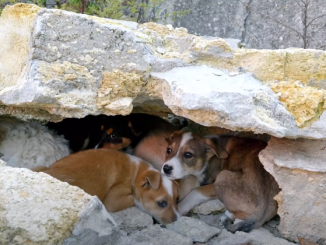
As the availability of COVID-19 tests dwindle across Canada, another option to detect the virus in the form of a furry friend may be the next best thing.
Multiple studies show that dogs can be more effective, faster and potentially less expensive than the current tests on the market.
The research has grown since 2020, with University of California Santa Barbara professor Tommy Dickey finding the collective research shows trained scent dogs are “as effective and often more effective” than both the rapid antigen tests many people keep in their homes, and even the PCR tests deployed at clinics and hospitals.
But even with studies showing their effectiveness, COVID-19-detecting dogs are deployed only in certain jurisdictions in various countries.
One such place is the Canines for Care program at Vancouver Coastal Health (VCH), which started looking into the possibility of training dogs to detect COVID-19 in early 2021.
Dr. Marthe Charles, division head of medical microbiology and infection prevention and control at VCH, said the idea stemmed from the early reliance on laboratory testing.
“I think there was a will from public health at the time and also from the various levels of government to try to find a way that was fast, accurate and non-invasive to be able to detect and train as many people as possible,” Charles told Global News in an interview.
Three dogs — two Labrador retrievers and an English springer spaniel — were brought in for training. The dogs were exposed to items such as masks that were worn by patients either negative or positive for the virus. This trained the dogs to recognize what is and is not COVID-19.

Charles said the dogs were trained since being puppies to associate the scent of COVID-19 with food and were rewarded each time they correctly detected a positive case of the virus.
“So from early on in their lives, they’ve associated the scent of a case of COVID to a rewarding scent,” she explained.
This reward method is not just used by VCM. It was also used with a group of dogs sourced in early 2021 for a French study, trained at detection using toys — usually tennis balls — as rewards.
Dr. Carla Simon, owner of Hunter’s Heart Scent Detection Canines in Calgary, said this method of training dogs is common. By using rewards, it can help motivate them to find the scent.
“We would pair, let’s say, the sweat samples with COVID, with their reward, and they notice that every time they find their reward, there’s that special smell,” she explained. “We just have to make it rewarding for the dog.”
She added, however, that the dog chooses the reward so trainers can ensure the canines “show up every day and want to do their job.”
Earlier this month, Dickey along with Heather Junqueira of BioScent, Inc. gathered several peer-reviewed studies into a review that was published in the Journal of Osteopathic Medicine. Dickey said the number of peer-reviewed studies over the past few years went from four to 29, incorporating the work of more than 400 scientists from more than 30 countries and 31,000 samples.
The review noted the effectiveness of dogs’ ability to detect COVID-19 comes down to their noses.

“The nose is not like humans,” Simon said. “It’s massively different, orders of magnitude different, and they can detect things without us being able to smell them.”
Humans have about five to six million olfactory receptors in their noses, while dogs have hundreds of millions. One-third of their brain is devoted to the interpretation of smell — something only five per cent of a human’s brain is committed to, according to Dickey’s review.
The study found dogs’ noses may even be able to detect pre-symptomatic COVID-19 cases, or even those who will develop symptoms later.
Dickey told us in an interview that this could help limit or stop the virus from spreading.
“The longer the wait is between your test and your result, that’s a latent period,” he said. “During that time you’re running around spreading COVID and you don’t know it. The dogs with a direct sniff will be done in seconds.”
Many of the studies conducted, including the work at VCH through the Canine for Care program, have shown dogs’ ability to detect the disease correctly with a success rate of more than 90 per cent. Additionally, the studies also showed a high speed at which the dogs could identify cases. In one study in Thailand, researchers reported the dogs had gone through thousands of samples in just a few weeks.
“The dogs take only one to two seconds to detect the virus per sample. Once they detect a patient, they will sit down,” said Chulalongkorn University professor Kaywalee Chatdarong, who led the 2021 project. “This takes only one to two seconds. Within one minute, they can manage to go through 60 samples.”
Even though the research suggested deploying scent-detection dogs could also be less expensive than rapid or PCR tests, Charles cautioned the logistics that go into training the dog is where it becomes “more prohibitive.”

In VCH’s case, training of the dogs included the medical microbiology lab to provide samples for use, working with infection prevention teams and control nurses, and if a dog identifies an area of concern, cleaning services may need to be utilized. And when it comes to rolling out testing using the dogs, enough staffing is needed for mass screening.
Despite this, while Charles says deploying the dogs widely could be difficult due to staffing and training, they are still one of several tools that can be used in COVID-19 detection.
“I think the way to see those dogs from my perspective is really like another tool in the toolbox and trying to prevent further transmission of pathogen of concern,” she said.
Dickey and Junqueira say dogs should have a place in “serious diagnostic methodology” including in helping should the world face a future pandemic.
After finding a caring home, a dog who lost part of his face can’t stop grinning.
A call that left Brittany Faske, a volunteer with the rescue organisation ADORE (All Dogs Official Rescue Enterprise of Houston), anxious came in January. A construction worker in Houston, Texas, noticed an injured Pit Bull with half of its face missing. According to the man, the dog hid in the bush and refused to allow anyone approach too close.
The woman was taken aback by the call and rushed to the spot. When she discovered the dog beside a ditch among the bags of food leftovers and old tyres, she realised he was in far worse condition than she had anticipated. The dog was in such horrible shape that she thought the best she could do was relieve his agony.

“This once-beautiful, big, and strong dog had been reduced to almost nothing.” He was so skinny that his ribs, hip bones, and backbone were clearly visible beneath his skin, in addition to his injuries. “He was covered in dirt and very weak,” Brittany explained to The Dodo.
The dog made a warning growl as she approached, but it didn’t startle her. She didn’t expect a different reaction from him, given the situation he was in and everything he had to go through and suffer through to remain that way.
After a while, the dog let Brittany to approach close enough to examine her injuries. The animal’s nose and snout were missing, and what was left hung in front of her face.
Brittany instantly realised it couldn’t have been an accident because the cut was so straight it could only have been made with a sharp instrument. So, that dog scenario was most likely the act of a human being, possibly the same one who left him lying there. In addition to the horrific sight of the wounds, the dog reeked of infection.
Brittany took Apollo, the dog she named, to the veterinarian after gaining his trust. Despite appearing to be in excruciating pain, the dog managed to relax and even fall asleep in the woman’s car. However, he was not yet fully safe.

The dog required immediate medical attention, and Brittany was unsure if he could handle the therapies that were to follow. However, when Apollo arrived at the clinic, he trotted around the waiting area, sniffing people and interacting with the other dogs.
Apollo had heartworm, a disorder that arises when parasitic worms move through a dog’s tissues to its heart and can lead to death if left untreated, in addition to his facial injuries.
Brittany and the vet placed food and water in front of Apollo to determine his quality of life and ability to eat properly. He could have a shot if he can do it.
Apollo ate two bowls of food and water without hesitation. Then Apollo approached the woman who had saved him and rested his head on her leg. “From that moment on, we knew he wasn’t just any dog,” Brittany explained.

Apollo eventually underwent reconstructive surgery. The dog’s exterior nose had been removed, but he still had a nasal cavity through which he could breathe. During the procedure, the veterinarian wrapped a skin graft around the exposed bone in Apollo’s nasal cavity to protect what was left of his nose. While the vet had to remove part of the dog’s top jaw and some teeth, he was still able to maintain enough of his mouth for him to eat and drink regularly.
Meanwhile, Brittany had not considered adopting the dog; she was simply concerned with the surgery and the dog’s recovery. She knew, though, that she and Apollo had formed a special link that was growing stronger by the day.
Brittany introduced Apollo to her other dogs, two males over the age of ten. “They were powerful breeds with volatile temperaments.” Two old men who are grumpy. I wasn’t sure if they could take another dog. “They were used to being just the two of them and were very protective of me,” she explained.

Once again, Apollo outperformed Brittany’s expectations. Apollo not only accepted the new dog, but he also adored the elder dogs. Another surprise element about Apollo was that he enjoyed being among others, which was unexpected given what he had been through. After that, Brittany made the obvious decision to officially adopt Apollo.
Apollo now lives a full life despite his facial injuries. His repaired nose functioned like any other dog’s nose, allowing him to breathe, smell, and sneeze normally. His reconstructed jaw does not prevent him from eating or playing.

Apollo enjoys cuddling up in the recliner with Brittany and watching TV, playing with his dog brothers, eating, and sunbathing. Furthermore, the dog received personalised training sessions at a Total Control K9 College K9 course, where he attends classes every Saturday and appears to like it.
Apollo was able to overcome his emotional traumas thanks to Brittany’s devotion, which also made him a very caring and affectionate dog. “I’ve never met a happier dog.” “You can see their trust and love in their eyes,” Brittany says.



Leave a Reply